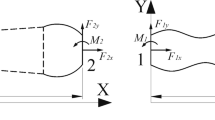Abstract
A two-dimensional flexure hinge mechanism with a novel structure is proposed to improve the transmission accuracy and efficiency of precision positioning worktables that are driven by giant magnetostrictive actuators. First, the static and dynamic mathematical models of the output displacement and input force of the flexure hinge mechanism are established on the basis of J.M. PAROS’s theory of flexure hinge design. Second, the geometric size of the flexure hinge is optimised through the numerical simulation analysis method, and the optimal design parameters are obtained in accordance with the requirement of the positioning stroke of the precision positioning worktable and the output displacement of the giant magnetostrictive actuator. Third, the vibration characteristics of the flexure hinge mechanism are analysed, and natural frequencies are obtained on the basis of an established dynamic equation. Finally, the finite element, numerical analysis and experimental verification methods are adopted to verify the accuracy of the established static and dynamic models. Results show that the calculation errors of the X- and Y-direction models are 3.35% and 3.23%, respectively and the magnitude error of dynamic model is 6.7%. These results indicate that the precision of the static model is high. Modal analysis shows that the inherent frequency of the flexure hinge mechanism is 963.76 Hz and that the error of theoretical calculation is only 3.1%. These results indicate that the established dynamic model has high precision. The flexure hinge mechanism demonstrates ideal performance when the damping ratio is 0.6.


















Similar content being viewed by others
References
Bea Jin-Ho, Nath Sankar Deb, Kim Sung-Gaun (2013) Development of an electric performance testing system for ceramic chips using a PZT actuator. Int J Precis Eng Manuf 14(4):613–618
Cai K, Tian Y, Wang F, Zhang D, Shirinzadeh B (2016) Development of a piezo-driven 3-DOF stage with T-shape flexible hinge mechanism. Robot Comput Integr Manuf 37:125–138
Caofeng Yu, Chuanli Wang, Tian Xie, Linjian Yang, Zhi Jiang (2019) Development of drive system of high performance micro positioning worktable based on giant magnetostrictive material. J Mech Eng 55(9):136–143
Gibson RF (2016) Principles of composite material mechanics. CRC Press, Boca Raton, pp 10–12
Guttner WC, Pesce CP (2016) On Hamilton’s principle for discrete systems of variable mass and the corresponding Lagrange’s equations. J Braz Soc Mech Sci Eng 39(6):1969–1976
Li Y, Xu Q (2011) A novel piezoactuated XY stage with parallel, decoupled, and stacked flexure structure for micro-/nanopositionin. IEEE Trans Ind Electron 58(8):3601–3615
Li J, Zhao H, Qu X (2015) Development of a compact 2-DOF precision piezoelectric positioning platform based on inchworm principle. Sens Actuators A Phys 222:87–95
Lin C, Yu J, Wu Z, Shen Z (2019) Decoupling and control of micromotion stage based on hysteresis of piezoelectric actuation. Microsyst Technol 25(9):3299–3309
Lobontiu N (2015) Planar flexible hinges with curvilinear-axis segments for mechanisms of in-plane and out-of-plane operation. J Mech Des (NY) 137(1):012302
Lobontiu N, Paine JSN, Garcia E (2002) Design of symmetric conic-section flexure hinges based on closed-form compliance equations. Mech Mach Theory 37(5):477–498
Pei X, Yu J, Zong G (2010) An effective pseudo-rigid-body method for beam-based compliant mechanisms. Precis Eng 34(3):634–639
Qin Y, Tian Y, Zhang D (2012) Design and dynamic modeling of a 2-DOF decoupled flexure-based mechanism. Chin J Mech Eng 25(4):688–696
Qingsong X (2015) Design of asymmetric flexible micro-gripper mechanism based on flexure hinges. Adv Mech Eng 7(6):1687814015590331
Wang N, Zhang Z, Zhang X (2018) Optimization of a 2-DOF micro-positioning stage using corrugated flexure unit. Mech Mach Theory 121:683–696
Wang F, Huo Z, Liang C (2019) A novel actuator-internal micro/nano positioning stage with an arch-shape bridge type amplifier. IEEE Trans Ind Electron 66(12):9161–9172
Yingfei W, Zhaoying Z (2002) Design of flexure hinges. Eng Mech 19(6):136–140
Zhang X, Xu Q (2018) Design and testing of a new 3-DOF spatial flexure parallel micropositioning stage. Int J Precis Eng Manuf 19(1):109–118
Zhang M, Liu Z, Zhu Y (2019) Design and analysis of a piezo-actuated flexure-based scanning system in ECDLs. Smart Mater Struct 28(10):105017
Acknowledgements
This work is supported by National Natural Science Foundation of China (Project No. 51675003) and China Postdoctoral Science Foundation (No. 2019M652159) and Natural Science Research Projects of Colleges and Universities in Anhui Province (No. KJ2019A0111) and Youth Natural Science Foundation of Anhui University of Science and Technology (No. QN2018102).
Funding
National Natural Science Foundation of China (51675003), Postdoctoral Research Foundation of China (2019M652159), Natural Science Research Projects of Colleges and Universities in Anhui Province (KJ2019A0111), Youth Natural Science Foundation of Anhui University of Science and Technology (QN2018102)
Author information
Authors and Affiliations
Corresponding author
Additional information
Publisher's Note
Springer Nature remains neutral with regard to jurisdictional claims in published maps and institutional affiliations.
Rights and permissions
About this article
Cite this article
Yu, C., Xiong, M., Cui, L. et al. Transmission characteristics of a two-dimensional flexure hinge mechanism. Microsyst Technol 26, 1223–1234 (2020). https://doi.org/10.1007/s00542-019-04652-4
Received:
Accepted:
Published:
Issue Date:
DOI: https://doi.org/10.1007/s00542-019-04652-4




